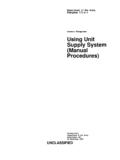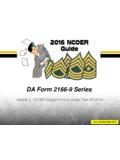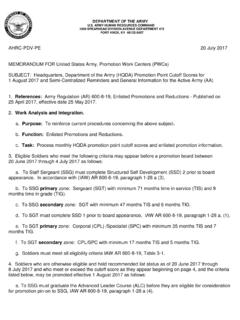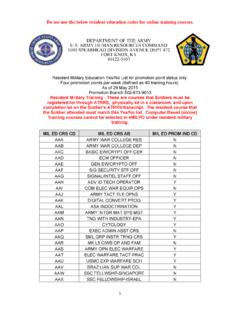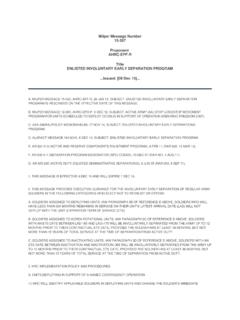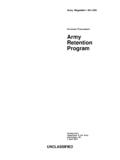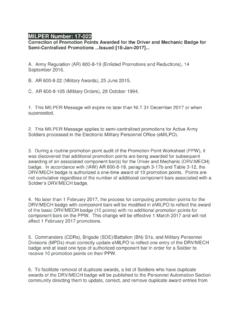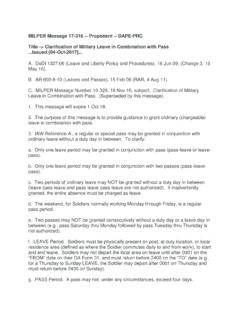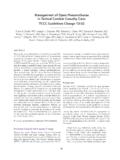Transcription of Expert Field Medical Badge Worksheets - NCOsupport.com
1 Expert Field Medical Badge Worksheets Expert Field Medical Badge Test Control Office Expert Field Medical Badge (A Portrait of Excellence) The Expert Field Medical Badge (EFMB) was designed as a special skill award for recognition of exceptional competence and outstanding performance by Field Medical personnel and approved by the Department of the Army on 18 June 1965. The Expert Field Medical Badge may be awarded to all officers assigned or detailed to an Army Medical Department (AMEDD) corps; Army officers in training at the Uniformed Services University of the Health Sciences; Army officers enrolled in the Health Professions Scholarship Program; warrant officers who have an AMEDD primary Military Occupational Specialty (MOS) controlled by The Surgeon General; warrant officer pilots that have a special qualification identifier "D" (Aeromedical Evacuation Pilot) and are assigned to an air ambulance unit; and enlisted personnel who have an AMEDD primary MOS or MOS 18D, this includes all MOSs in the Career Management Field (CMF) 68.
2 REPRODUCIBLE SCORE SHEETS A-1. GENERAL. The various score sheets included within this appendix are designed for EFMB use only and prescribe the testing standards for use during EFMB. They may be reproduced locally as needed. EFMB Test Score Sheet LAND NAV NAVIGATE FROM ONE POINT TO ANOTHER DURING THE DAY (For use of this form, see AMEDDC&S Pam 350-10, the proponent is MCCS-OP-T) CANDIDATE S RANK AND NAME CANDIDATE # TASK: NAVIGATE FROM ONE POINT TO ANOTHER DURING THE DAY. CONDITIONS: Given a standard topographic map, scale 1:50,000; a lensatic compass; Graphic Training Aid (GTA) 05-02-012 (coordinate scale and protractor); a pencil; a score sheet; and the eight-digit grid coordinates of the start point, three intermediate points, and end point. STANDARDS: Plot the start point, intermediate points, and the end point on the map. Navigate from the start point, through each intermediate point, in order, to the end point, and correctly record at least three points within 3 hours.
3 NOTE: THIS TASK HAS BEEN MODIFIED FOR EFMB TESTING PURPOSES USE ONLY. PERFORMANCE STEPS/MEASURES GO NO-GO 1. Plot points on the map. 2. Navigate from the start point, through the intermediate points, to the end point. 3. Correctly record the point number or letter of at least three points, excluding the start point. 4. Complete all performance measures within 3 hours. 5. Return the map and score sheet. DAY LAND NAVIGATION COURSE LANE # _____ START TIME: _____ END TIME: _____ TOTAL TIME : ____ Hours _____ Minutes END POINT CADRE SIGNATURE: _____ 8 DIGIT GRID COORDINATES POSITION STAKE NUMBER GO NO-GO START POINT 1st POINT 2d POINT 3rd POINT END POINT TOTAL CORRECT/ INCORRECT POINTS REASON(S) FOR FAILURE DOES THE CANDIDATE WISH TO REBUT THIS TASK? (CANDIDATE INITIALS APPROPRIATE BOX) YES NO LANE OIC/NCOIC INITIALS EVALUATOR S SIGNATURE DATE worksheet # 001 to construct AMEDDC&S Form 1232, 1 NOV 11 EFMB Test Score Sheet LAND NAV NAVIGATE FROM ONE POINT TO ANOTHER DURING THE NIGHT (For use of this form, see AMEDDC&S Pam 350-10, the proponent is MCCS-OP-T) CANDIDATE S RANK AND NAME CANDIDATE # TASK: NAVIGATE FROM ONE POINT TO ANOTHER DURING THE NIGHT.
4 CONDITIONS: Given a standard topographic map, scale 1:50,000; a lensatic compass; Graphic Training Aid (GTA) 05-02-012 (coordinate scale and protractor); a pencil; a score sheet; a red-lens flashlight; a chemical light stick for emergency use; and the eight digit grid coordinates of the start point, three intermediate points, and end point. STANDARDS: Plot the start point, intermediate points, and the end point on the map. Navigate from the start point, through each intermediate point, in order, to the end point, and correctly record at least three points within 4 hours. NOTE: THIS TASK HAS BEEN MODIFIED FOR EFMB TESTING PURPOSES USE ONLY. PERFORMANCE STEPS/MEASURES GO NO-GO 1. Plot points on the map. 2. Navigate from the start point, through the intermediate points, to the end point. 3. Did not mark the route of travel with the flashlight. 4. Correctly record the point number or letter of at least three points, excluding the start point.
5 5. Complete all performance measures within 4 hours. 6. Return the map and score sheet. NIGHT LAND NAVIGATION COURSE LANE # _____ START TIME: _____ END TIME: _____ TOTAL TIME : ____ Hours _____ Minutes END POINT CADRE SIGNATURE: _____ 8 DIGIT GRID COORDINATES POSITION STAKE NUMBER GO NO-GO START POINT 1st POINT 2d POINT 3rd POINT END POINT TOTAL CORRECT/INCORRECT POINTS REASON(S) FOR FAILURE DOES THE CANDIDATE WISH TO REBUT THIS TASK? (CANDIDATE INITIALS APPROPRIATE BOX) YES NO LANE OIC/NCOIC INITIALS EVALUATOR S SIGNATURE DATE worksheet # 002 to construct AMEDDC&S Form 1232, 1 NOV 11 EFMB Test Score Sheet TCCC PERFORM A tactical COMBAT CASUALTY CARE PATIENT ASSESSMENT (For use of this form, see AMEDDC&S Pam 350-10, the proponent is MCCS-OP-T) CANDIDATE S RANK AND NAME CANDIDATE # TASK: PERFORM A tactical COMBAT CASUALTY CARE PATIENT ASSESSMENT.
6 CONDITIONS: Given multiple trauma casualties in a simulated combat environment and necessary equipment to perform applicable performance steps and measures. STANDARDS: Perform all steps and measures IAW the concepts and principles of tactical Combat Casualty Care and the EFMB Program without causing further injury to the casualties. NOTE: THIS TASK HAS BEEN MODIFIED FOR EFMB TESTING PURPOSES ONLY. PERFORMANCE STEPS/MEASURES GO NO-GO NOTE: Performance steps/measures that are evaluated in other EFMB TCCC tasks ( Control Bleeding Using a Tourniquet task) will not be marked as a NO-GO on this task as long as they were attempted at the appropriate phase in the CTL. Performance of a step/measure during the wrong phase ( , splinting a fracture in the care under fire phase) or not performing at all will be marked as a NO-GO on this task. 1. Perform care under fire procedures. a. Take cover. Return fire as directed or required before providing Medical treatment.
7 B. Direct the casualties to return fire, if able. c. Determine the scene safety/security. NOTE: Despite fire superiority being gained during the care under fire phase of care, it does not mean that the enemy threat has been eliminated. You must exercise caution when maneuvering to casualties utilizing available cover, concealment, and suppressive fire. If the tactical situation permits have the casualties move to your position exercising the same caution. NOTE: You must determine the relative threat of the tactical situation versus the risk to the casualty. Can you remove the casualty to a place of relative safety without becoming a casualty yourself? Is the casualty safer where he is? If possible, seek assistance from your leader. d. Determine the number and location of the injured and severity of their injuries (Evaluated IAW Triage Casualties task). e. Direct team members/combat life savers to assist, if available.
8 NOTE: For EFMB testing purposes, the candidate cannot direct other individuals or a casualty to perform tasks that he is being evaluated on. This is also applicable for other performance steps/measures within this task. For example, the candidate cannot direct a team member to control bleeding using a tourniquet and only check that it was applied correctly. The candidate must be evaluated on performing each of the TCCC tasks at least once. f. Assess the casualties for life threatening extremity hemorrhage. NOTE: Once fire superiority has been gained begin assessing and treating life threatening hemorrhage. (1) If the casualty is unresponsive or unable to move and has severe extremity bleeding, administer life-saving hemorrhage control before moving the casualty. (a) Use a tourniquet for hemorrhage that is anatomically amenable to tourniquet application (Evaluated IAW Control Bleeding with Tourniquet task).
9 (b) For hemorrhage that cannot be controlled with a tourniquet, apply a hemostatic dressing (Evaluated IAW Control Bleeding with Hemostatic Device task). (2) Direct the casualty to control hemorrhage by self-aid if he is able. g. Communicate the Medical situation to the team leader, the evaluator for EFMB testing purposes (Evaluated IAW Triage Casualties task). h. Tactically transport the casualty, his weapon, and mission-essential equipment to cover, as required (Evaluated IAW Evacuate Casualties tasks). NOTE: If the casualty has equipment that is essential to the mission, move the mission-essential equipment also. Do not try to move equipment that is not mission essential. worksheet # 003 to construct AMEDDC&S Form 1232, 1 NOV 11 Page 1 of 7 i. If casualty is unresponsive, move the casualty and his weapon to cover as the tactical situation permits (Evaluated IAW Evacuate Casualties tasks).
10 J. Recheck the bleeding control measures as the tactical situation permits. 2. Perform tactical Field care procedures. a. Immediately disarm any casualty with an altered mental status. b. Communicate updates to the Medical situation to the unit leader in the following situations (Evaluated IAW Triage Casualties task). (1) Upon determining that the casualty will not be able to continue with the mission. (2) Before initiating any Medical procedures. Ensure that the tactical situation allows for time to treat the casualty before initiating any Medical procedures. (3) Upon any significant change in the casualty s status. c. Take body substance isolation (BSI) precautions. d. Perform an initial assessment. NOTE: If multiple casualties exist, at a minimum, the initial assessment will be completed on each casualty before moving to the next casualty unless they are expectant.
